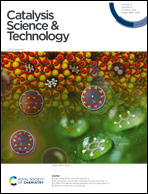Heterogeneous catalysis with an organic–inorganic hybrid based on MoO3 chains decorated with 2,2′-biimidazole ligands†
Abstract
The discovery of selective heterogeneous catalytic systems for industrial oxidation processes remains a challenge. Molybdenum oxide-based polymeric hybrid materials have been shown to be oxidation catalysts under mild reaction conditions, although difficulties remain with catalyst recovery/reuse since most perform as homogeneous catalysts or possess low activity. The present study shows that the hybrid material [MoO3(2,2′-biimidazole)]·H2O (1) is a superior catalyst regarding these issues. The structure of 1 was confirmed (by single crystal and synchrotron X-ray powder diffraction) to comprise one-dimensional chains of corner-sharing {MoO4N2} octahedra. Strong Mo![[double bond, length as m-dash]](https://www.rsc.org/images/entities/char_e001.gif) O⋯H–N hydrogen bonds separate adjacent chains to afford parallel channels that are occupied by disordered water molecules. Hybrid 1 was additionally characterised by FT-IR spectroscopy, 1H and 13C MAS NMR, scanning electron microscopy and thermogravimetric analysis. The catalytic studies highlighted the versatility of 1 for oxidation reactions with tert-butylhydroperoxide as oxidant. By complementing with characterisation studies, it was verified that the reaction occurs in the heterogeneous phase, the catalyst has good stability and is recoverable via simple procedures. The chemical reaction scope covered epoxidation and sulfoxidation, and the substrate scope included biomass-derived DL-limonene and fatty acid methyl esters to give renewable bio-products, as well as thiophene and thioanisole substrates.
O⋯H–N hydrogen bonds separate adjacent chains to afford parallel channels that are occupied by disordered water molecules. Hybrid 1 was additionally characterised by FT-IR spectroscopy, 1H and 13C MAS NMR, scanning electron microscopy and thermogravimetric analysis. The catalytic studies highlighted the versatility of 1 for oxidation reactions with tert-butylhydroperoxide as oxidant. By complementing with characterisation studies, it was verified that the reaction occurs in the heterogeneous phase, the catalyst has good stability and is recoverable via simple procedures. The chemical reaction scope covered epoxidation and sulfoxidation, and the substrate scope included biomass-derived DL-limonene and fatty acid methyl esters to give renewable bio-products, as well as thiophene and thioanisole substrates.



 Please wait while we load your content...
Please wait while we load your content...